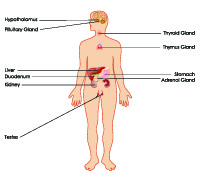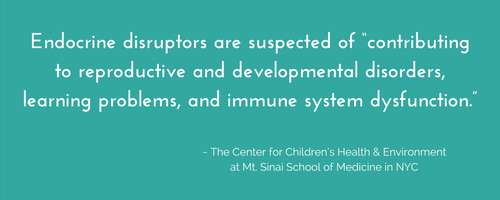
You have probably heard the term “endocrine disruptors” quite a bit when it comes to household toxins and personal care products, or you might have heard them called by their other common name: hormone disruptors.
But what are they really, and how do they affect our health?
What Does the Endocrine System Do?
The endocrine system is where our body’s hormones are made, stored, and secreted. It consists of eight glands: the thyroid, pituitary gland, hypothalamus, pineal gland, adrenal glands, pancreas, ovaries, and testes.

There are hormones for every function in our body (not just what we blame when we’re crabby!).
There are hormones for sleep, appetite, sleep cycles, mood, blood sugar, heart rate, thyroid, fertility, blood pressure, metabolism, and for the immune system, just to name a few.
In short, the endocrine system regulates every function of the body.
What is an Endocrine Disruptor?
An endocrine disruptor is a man-made chemical or substance that interferes with the function of the endocrine system. They can do this several ways by:
- Imitating hormones
- Blocking hormones and preventing them from doing their job
- Producing or secreting hormones when they’re not needed
- Causing an over- or under-production of hormones
So if you can imagine a synthetic man-made material imitating or getting in the way of a messenger trying to do its job, you can see where these health issues can crop up.
Endocrine disruptors can wreak havoc all over the body, and are linked to health effects such as weight gain, insulin resistance, diabetes, allergies, asthma, cardiovascular disease, fertility issues, thyroid problems, increased cancer risk, and even neurodevelopmental disorders (such as ADHD, learning disabilities, and autism), and lower IQ.
Research shows that endocrine disruptors may pose the greatest risk during prenatal and early postnatal development when organ and neural systems are forming.

How Endocrine Disruptors Can Affect our Allergies & Immune System
Allergic diseases, including asthma, are the third most common chronic disease among children under 18 years old.
One reason for the increased levels of allergic responses may be the impact that environmental toxins have on the immune system, where these toxins appear to cause a disruption. Studies have suspected endocrine disruptors such as BPA in increasing the production of cells that lead to allergies.
A study published in the journal Allergy & Asthma Immuonlogy Research found that exposure to endocrine disruptors can result in “dramatic” changes in the immune system, including the release of substances that cause an allergic response to occur.
The journal also stated that the development of the immune system, especially before birth, has “far-reaching consequences during early childhood and throughout adult life.”
So it’s something to keep in mind: when we’re exposing ourselves, our children, and even our unborn babies to these toxicants that are altering our immune systems, it can have life-long consequences. In addition to allergies and asthma, they can also lead to cancers, autoimmune disease, and so many other chronic illness that are so common now.
Basically, when is the most important time to avoid toxins? Before birth.
Endocrine Disruptors and Lower IQ
There are a couple of specific endocrine disruptors that have made news recently for lowering IQ: BPA and phthalates (pronounced thalates).
The Yale School of Medicine found that “low doses of BPA can impair brain function and may lead to learning disabilities.” BPA is what is commonly used in plastic bottles, plastic re-usable food containers, and canned foods, so it is in a lot of products that we are exposed to daily.
Increased toxin exposure can lead to ADHD, dyslexia, cerebral palsy, lowered IQ, sensory deficit issues, memory problems, and other issues that can cause harm to a child’s brain.
Studies have recently shown that phthalates have also been linked to reduced IQ in children who have had prenatal exposure.
For example, research from Columbia University has shown that children born to mothers who had the highest urinary phthalate levels had IQs that were 6-7 points lower at age 7 than those children born to mothers with lower levels of phthalates in their bodies.
This is especially troubling because a 6 or 7 point deficit in IQ can have major repercussions both in school and later, when it comes to work life.
How Endocrine Disruptors Affect Our Weight
Endocrine disruptors that alter the metabolism, predisposing people to gain weight are known as “obesogens.”
They are a class of chemicals that promote obesity by increasing the number of fat cells and the storage of fat in existing cells or by altering metabolic regulation of appetite and satiety.
Obesogens are believed to promote weight gain and obesity in a few different ways, including:
- Disrupting metabolism
- Increasing the size and number of fat cells
- Affecting thyroid function
- Altering appetite and satiety (feeling “full” or satisfied after eating).
- Accumulating in the body, where they are stored in fat cells
Pre-natal and early childhood exposure to these obesogens may alter an individual’s metabolism and fat-cell composition for life. They can known act on the genes in the developing fetus, predisposing them to become fat cells, proving this damage can occur even before birth.

Where are Endocrine Disruptors Found?
In just about everything! The can be lurking in everything from your food to your personal care and beauty products, and even in medicine. The good news is that you can greatly reduce your exposure if you know what to be on the lookout for.
Some common endocrine disruptors include:
- Pesticides
- Phthalates
- Parabens
- Flame retardants
- BPA
- Triclosan
- Teflon
- Acetaminophen (Tylenol) and aspirin
How to Avoid Endocrine Disruptors
Here are some common endocrine disruptors, and where they’re found:
Phthalates and Other Plasticizers
- Vinyl shower curtains and flooring
- Scented items – air fresheners, cleaners, cosmetics, laundry detergents, shampoos & shaving creams, just to name a few
- Plastic food storage containers
- Soft vinyl bath toys
- Nail polish
PFCs (Used to make products stain-resistant, waterproof, or non-stick).
- Clothing with the name brand Gore-Tex or Scotchguard
- Non-stick cookware, made with Teflon
- Pizza bags
- Microwave popcorn bags
- Cosmetics
BPA/BPS
- Store, bank, and gas station receipts
- Water bottles (even those labeled BPA-free)
- Canned foods (such as) soups and canned tomatoes
Parabens
- Personal care products such as hair products, body wash, lotion, deodorant, shave creams, and anti-aging moisturizers
- Cosmetics, such as eyeshadow, lipstick, foundations, and chapstick.
- Look for propylparaben, ethylparaben, or butylparaben, which are ones commonly used in cosmetics
- Snack foods, such as Sara Lee’s Cinnamon Rolls and Weight Watchers’ Lemon Creme Cakes (click here to see a more complete list, and be sure to check labels – ingredients can change quickly!).
Flame Retardants
- Furniture, such as polyurethane foam products (mattresses, upholstered furniture, pillows, etc.)
- Flame-resistant clothing, such as infant and toddler pajamas
- Electronics
- Building foam insulation
- Soda (Mountain Dew)
Related: How Flame-Retardants May Be Affecting Your Child’s Learning and Behavior (Plus a free guide on how to reduce Flame Retardants in Your Home)
Triclosan
- Antibacterial products, such as hand sanitizer
- Household products, such as cutting boards (look for the brand name Microban) and dishwashing liquids
- Personal care products, such as deodorant and toothpaste (Colgate brand)
- Antibacterial clothing, such as some sock brands (some are labeled with the brand “BioFresh”)
Related: Are You Brushing Your Teeth with a Pesticide? (Plus a free cheat sheet to avoiding triclosan).
Household Dust
Another place where endocrine disruptors are commonly found in the home? Household dust! Dust is a major source of exposure to flame retardant chemicals in the home. It can also contain phthalates, lead, and other toxic chemicals.
Be sure to damp mop (dry mopping can spread dust) and dust frequently to keep household dust at bay, especially in the areas where your children spend the most time.
Babies and toddlers like to spend a lot of time on the floor, so hit these places the hardest. Vacuuming carpets and floors with a HEPA filter will also help to reduce exposure.
How we Can Avoid Endocrine Disruptors
- Avoid products with the words “fragrance” or “perfume.”
- Look for products that say “phthalate-free,” “scented only with essential oils,” or “no synthetic fragrance.”
- Buy organic produce, meat, and dairy as much as possible to reduce phthalate exposure from pesticides.
- Avoid using scented candles, or plug-in air fresheners.
- Store food in glass storage containers, rather than plastic.
- Look for nail polish that says “phthalate-free.”
- Buy furniture and electronics that don’t contain flame retardants.
Sources:
Endocrine disrupters – Potential Modulators of the Immune System and Allergic Response
Obesogens: An Environmental Link to Obesity
Food Allergy Facts & Statistics
Prenatal Exposure to Common Chemicals Linked to Lower IQ
Painkillers in Pregnancy Linked to Male Infertility
Effects of Environmental Toxins of Allergic Inflammation
Neurobehavioral Effects of Developmental Toxicity
New York State’s Children & the Environment; Mt. Sinai’s Children’s Environmental Health Center
Analysis Finds Hormone Disruptor Used in Cosmetics in Nearly 50 Different Foods

